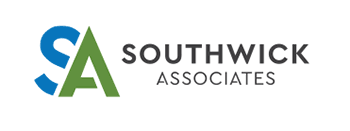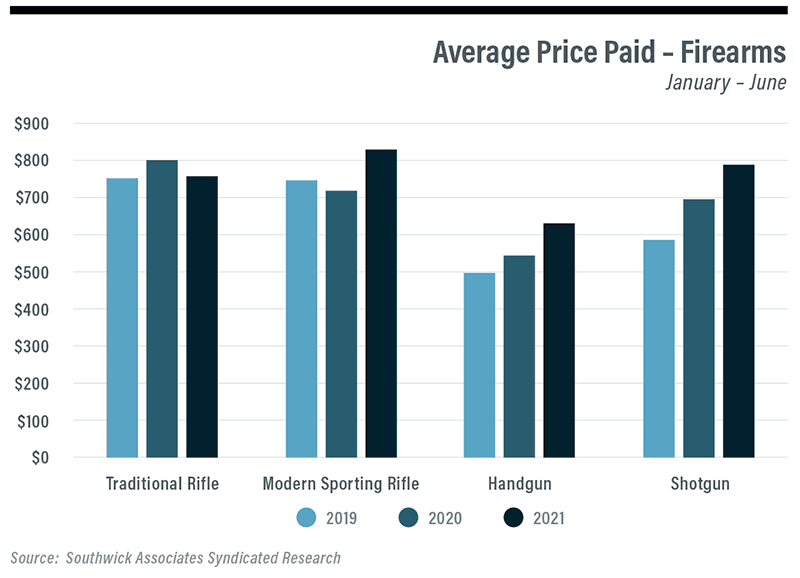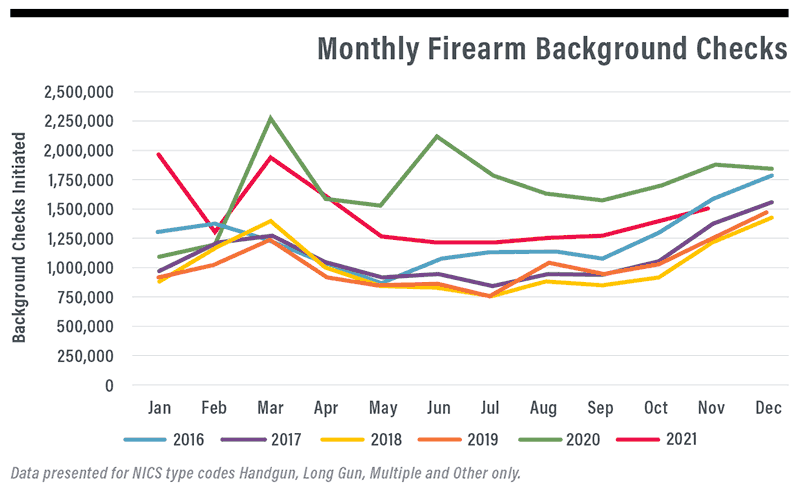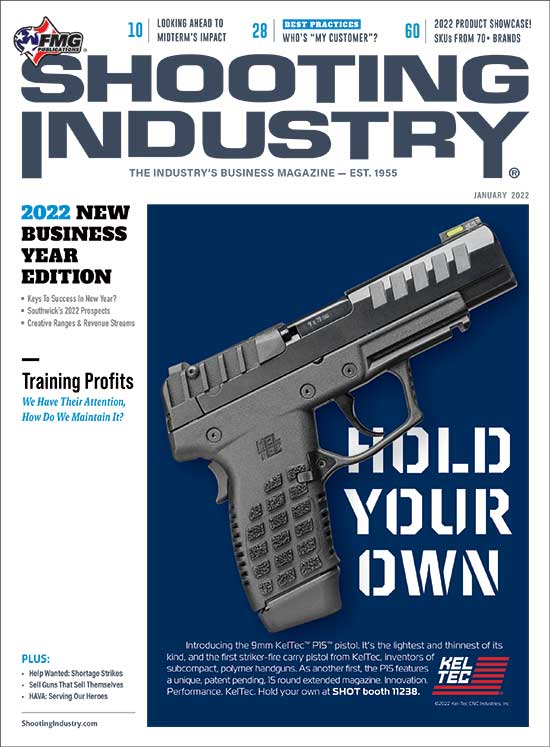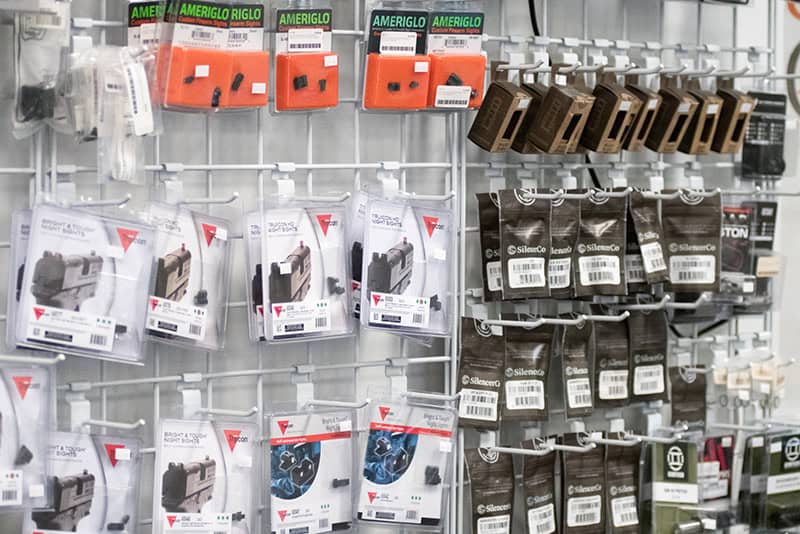2022 New Business
Year Outlook
Examining 2021 Trends Lends
Insight Into Early-Year Business
It’s good to see 2020 further and further behind us. Though the craziness of that year is subsiding, the grand sales run has continued. Demand and sales remain high so far through 2021. Before we speculate on what 2022 will bring, let’s first review 2021.
Looking Back At 2021
When 2021 began, inventories were depleted. As quick as retailers could receive firearms and ammunition, most were sold. Firearm sales were often suppressed when potential firearm consumers could not find matching ammunition. Many of 2020’s firearm purchasers are now buying accessories to support what was their first-ever firearm. 2021 is proving to be a better year for all sectors of our trade, not just firearms and ammunition. With demand high, discounting has generally not been needed, resulting in higher prices at all levels of the trade due to increased material and business costs.
In the first quarter of 2021, new firearm sales as measured by NICS data, with background checks for used firearms and permit checks excluded, increased 13.5% over the same quarter the prior year. Considering the COVID pandemic did not emerge until late in the first quarter of 2020, this growth rate for 2021 sales was expected. Sales in the second and third quarter in 2021 were down 22% and 25%, respectively. Don’t be alarmed by this decline. Comparing 2021 sales to 2020 is like comparing your income in the year after you won the lottery. 2021 sales, overall, were the second-highest ever recorded. It was a good year.
Part of the reason why 2020 sales were enormous related to the lack of excess firearms and ammunition inventory that was present in early 2020 but not in 2021. If larger inventories were on hand at the beginning of the year, sales would have been greater. Ammunition shortages also discouraged some consumers from buying firearms they would not be able to use.
Sales Trends
Considering the social unrest in 2020, when many sales were driven by people’s safety concerns, demand was focused on handguns. Handgun sales as of the end of September 2021 were 16% below the same time last year. Long-gun sales have only decreased 6% through the first three quarters of 2021. (Until more research is completed, it’s not possible to say whether long guns were growing in popularity or if consumers purchased them when unable to find the handgun they wanted for defense purposes.)
”We also strongly believe a gradually growing cultural interest in firearms and the right to self-defense is helping boost sales.“
Sales that involved more than one firearm in the same transaction declined 17%, indicating some of the so-called panic buying was easing. Subscribers to Southwick Associates quarterly reports know the trends in MSR, traditional rifle and shotgun sales.
The price increases due to increased business costs seen in late 2020 held in the first half of 2021. While traditional rifles may be the exception, MSRs, handguns and shotguns have all seen significant price increases in the face of tremendous demand. The ability to supply inventory at retail will determine if higher prices remain or if price easing and discounting might appear once inventories return to pre-COVID levels. Subscribers to Southwick Associates market monitoring services have access to price trends for ammunition and many accessory categories.
Imports Impact
One fact to note: in 2021, imports skyrocketed over 2020 levels — according to import data compiled by Southwick Associates. This trend may be the major factor contributing initial growth in wholesale and retail inventories. Recognizing the time needed for factories to produce and ship product, many months are often required before imports can arrive to help meet demand growth.
In the months leading up to the 2016 presidential election, manufacturers and distributors bet on increased demand after the election. When Republicans won, demand fell, and the bet did not pay off, resulting in high inventories throughout the entire channel. This time, the inventory is selling through, for now. That said, while imports of all types of firearms have significantly increased, shotgun imports have by far grown the most. This, in part, might help describe the current spike in shotgun sales as more shotguns are coming to market in proportion to handgun and rifles.
Inventories Are Replenishing — Slowly
As seen in the chart tracking NICS figures, sales are starting to recede back to levels experienced two to five years ago. Reports and feedback indicate firearm inventories at wholesale are growing, while product is hanging around a bit longer on ammunition shelves.However, demand remains very high.
At the end of Q2 2021, consumers reported to Southwick Associates they were not seeing increased availability of firearms or ammunition. In fact, two-thirds said they spent more time in the second quarter searching for desired product than they did in the first quarter. (It must be stressed that, when it comes to items not purchased daily — like coffee or bread — consumers are often the last to notice increased supplies. They typically don’t visit the store every day monitoring inventory levels at the rate the industry does.)
Southwick Associates thinks inventories are replenishing, as noticed by consumers and reported in surveys. Overall, as of early December 2021, product was still difficult to find at retail, but a very gradual return to normalcy appeared to be underway.
Accessory Sales
What about accessory sales in 2021? Southwick Associates monitors consumers’ firearms and accessories purchases and uses. From these data, we track the percentage of hunters, target shooters and personal-defense consumers’ quarterly purchases for specific product categories. A clear shift has appeared.
As shown in the table in this article, the proportion of purchases containing soft goods and various shooting accessories increased in the first half of 2021 compared to the year before. Ammunition showed a slight increase, probably because of more inventory becoming available, while the percentage of purchases that included firearms and firearm parts decreased in the first half of 2021. Accessory sales should remain strong moving forward.
Hunting Still Strong After “Lottery” Year
Though not growing as fast as firearm sales in general, hunting-related sales continued to do well in 2021. Based on state license sales data, though hunting license sales were down compared to the “lottery” year of 2020, for the first half of 2021, sales were up 8% over the first half of 2019 sales. In addition, the rate of first-time hunters entering the sport was the second-highest increase, with only 2020 generating more new hunters.
It remains incumbent on the trade to partner with state wildlife agencies to help these newcomers feel welcome and gain the knowledge they need to become confident, independent hunters. Contact Southwick Associates for research insights on new hunters’ greatest needs.
So, What About 2022?
Without a doubt, the large spikes in firearm sales seen in the early part of 2021 were partially related to the 2020 election. With the White House and Congress all blue, fears were stoked about new firearm restrictions. But the close balance between Republicans and Democrats in Congress is probably a reason why few major anti-firearm initiatives have been introduced, possibly out of fear of losing voters in midterm elections. But initiatives to restrict our Second Amendment rights continue at the state and local level. Remain vigilant.
For now, these ongoing actions certainly continue to drive demand to a degree. We also strongly believe a gradually growing cultural interest in firearms and the right to self-defense is helping boost sales and dissuades some politicians from taking anti-firearm positions. We don’t expect these political concerns to change anytime soon, though it could rapidly change. Likewise, considering Second Amendment-related cases going before the Supreme Court, any negative outcome toward firearm rights will further drive sales in the short term before causing long-term harm.
As mentioned, many consumers aren’t finding the product they want at retail. As more retail inventory becomes available, some customers are coming back to buy their preferred firearms plus ammunition. We expect this trend to continue into 2022, but at a lower rate as the year progresses. At some point, when inventories are back to normal and current logistics and shipping problems ease, firearm and ammunition sales will decline from 2020–21 levels.
Firearm and ammunition manufacturers are currently producing to fulfill current retail demand while also replenishing wholesale inventories. Once wholesale inventories are back to normal, manufacturer sales will probably dip greater than what will be seen in retail. At that time, discounts and promotions will likely be seen again and prices might ease. When all this happens is unknown. We expect by late 2022 to see more of this expected trend. By Q4 2022, we expect sales to be back to 2019 pre-COVID levels. (All this, of course, assumes no more major political or supply-side shocks.)
2020’s lockdowns fueled growth of online sales. This continued in 2021 and we see no reason for trends to shift back anytime soon. Firms better positioned online will see stronger sales than others — both retailers and manufacturers.
Re-Engagement Key
To maintain sales in 2022 and beyond, be sure to help engage 2020–21’s new firearm owners. Many new gun owners did not become active participants, either from limited opportunities to shoot, no one to go with, a lack of ammunition or knowledge.
The savvy retailer will remain in contact with first-time owners, encouraging them to visit a range and helping them become competent, comfortable users. Otherwise, our growth in the past two years will be just a bump on our long-term trend charts.
It’s up to all of us, as an industry, to help these new gun owners and ensure they become an active consumer/participant at the range and in the store.


